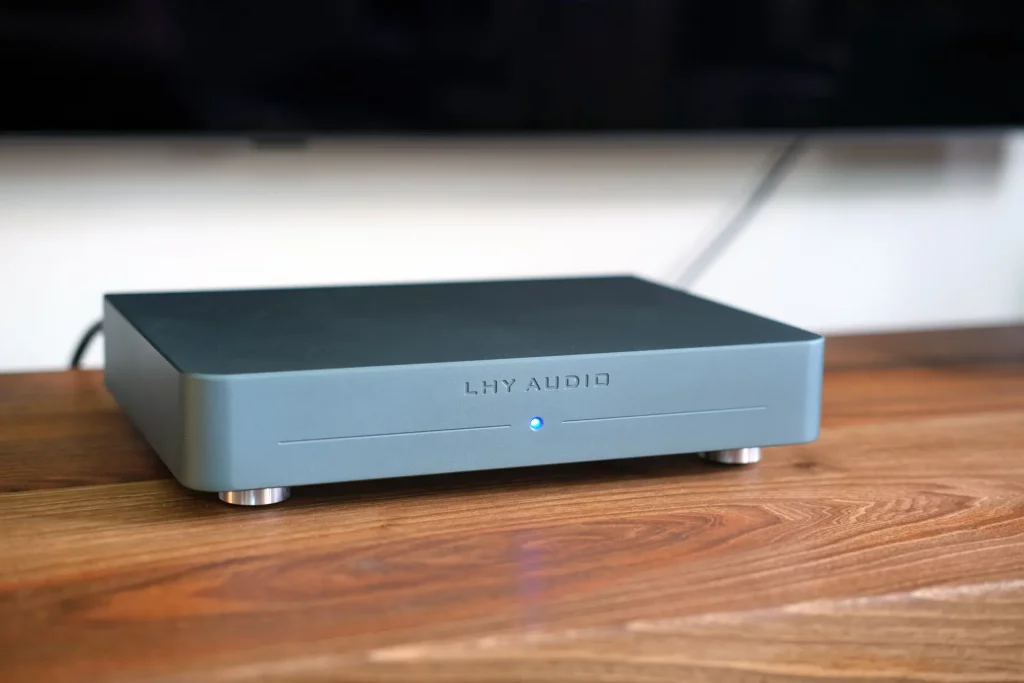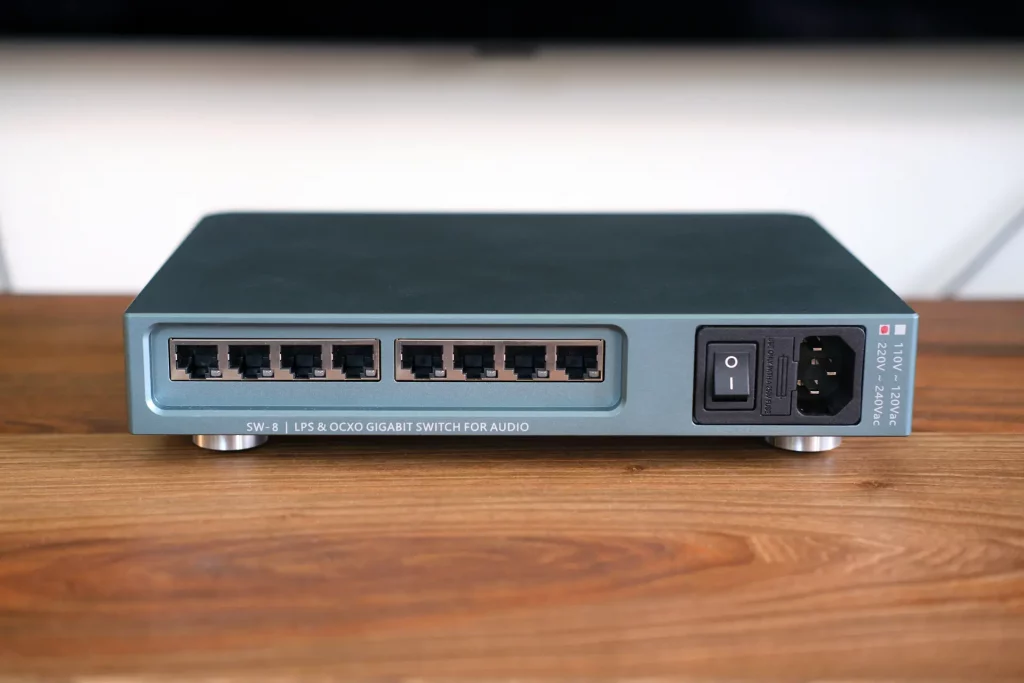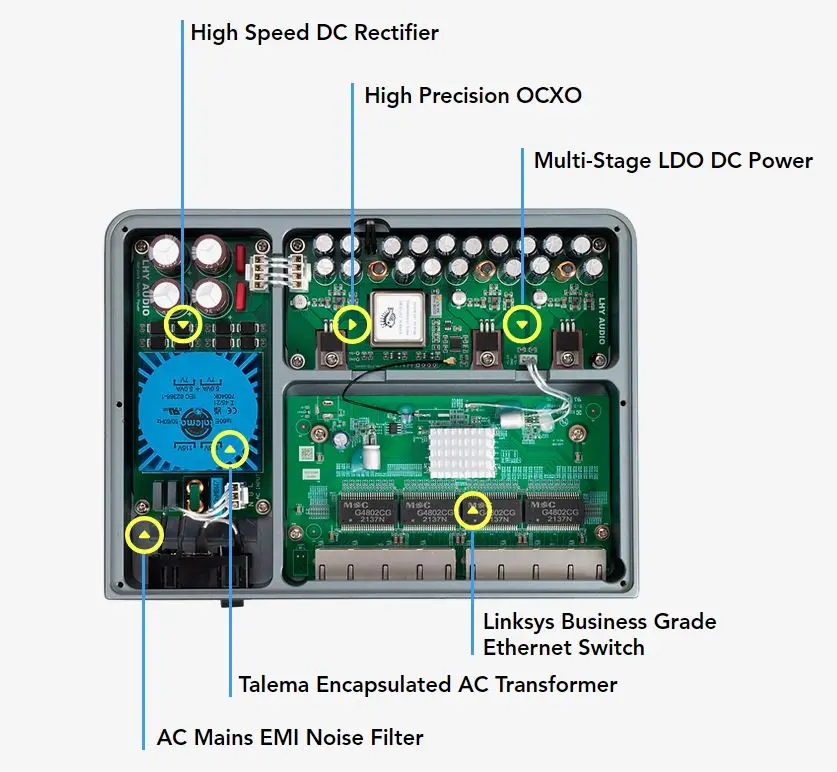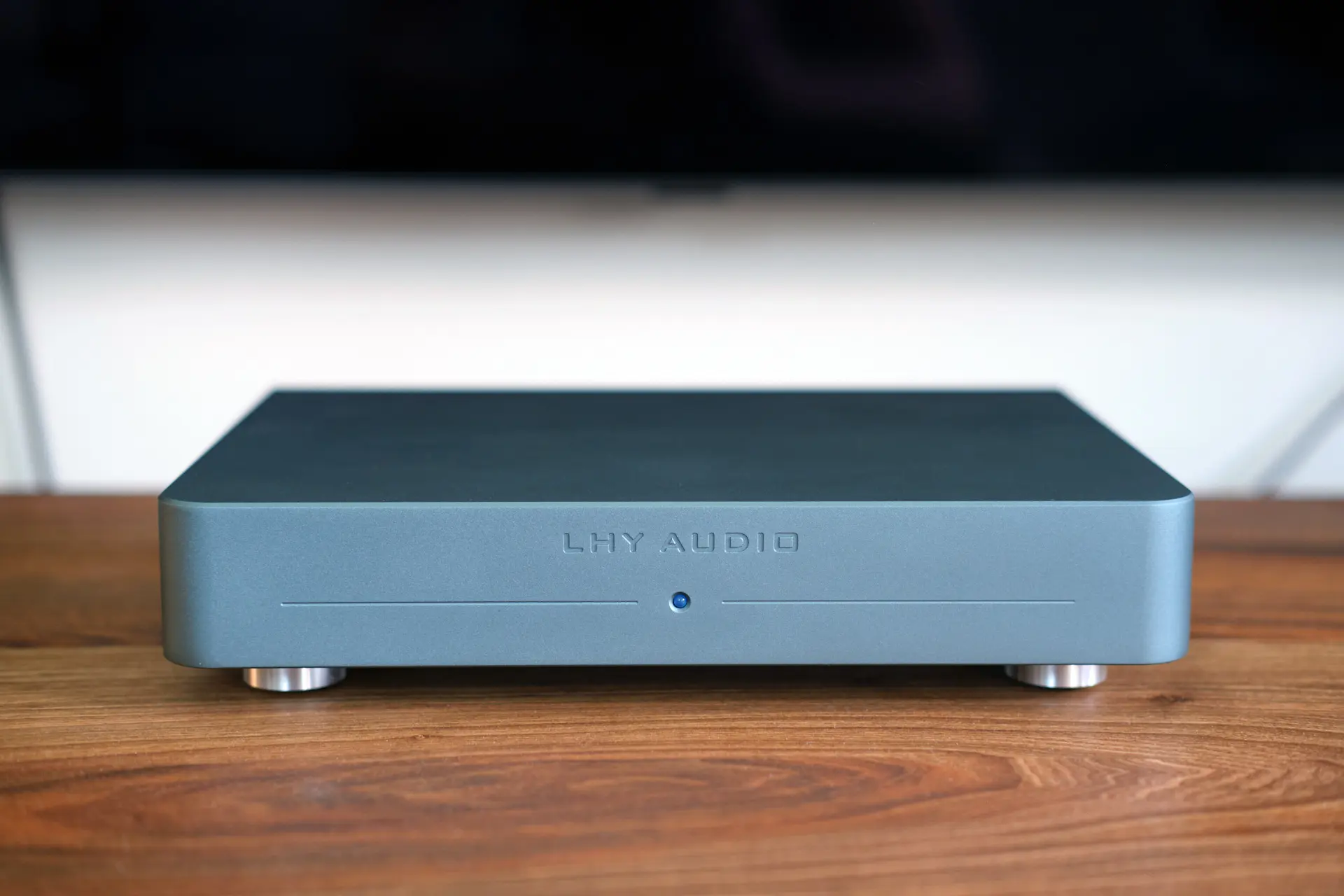LHY SW-8 is an audiophile switch and here I’ll present my impressions that come from personal use experience, without dwelling on any theory and measurements. If that sounds fishy to you and you’re easily triggered by what you believe to be audiophile “snake oil”, then better skip this one. This is for the crazy ones, the ones with bat ears, the ones that don’t need graphs to tell them what they’re allowed to hear – so let’s start.
Build and Features
LHY SW-8 is made of thick machined aluminum and finished to a high standard. Since the network switch doesn’t require any controls, the only thing you can find on the front of the unit is a blue LED that lets you know if the unit is powered on. The power switch itself and all ethernet ports are located on the back of the unit. There are eight of those which are indicated in the name itself. SW-8 is somewhat bigger than I would have expected a switch to be.


But size becomes understandable once you realize that it’s powered by AC, meaning that it has a fully integrated power supply and no external power brick. It got even more logical once I realized it’s a linear power supply too, with an encapsulated transformer and bank of capacitors. That is the first important part of the design that benefits both the device it powers, but also the other devices around it by not creating high-frequency switching noise that goes back into the power network and influences other devices too.
Talking about the design, it’s refreshing to see that the manufacturer doesn’t hide their recipe by covering it with black glue or sealing it in any other way. LHY is transparent about using Linksys LGS108 as a starting core for this switch. But they exchanged its whole power section for the mentioned linear power supply with good filtering. Also, a new and much higher quality OCXO is used. This acronym stands for Oven Controlled Crystal Oscillator, which is one of the best and most expensive clock implementations. You can see all of this in the image provided by the manufacturer itself.

But as much as I sometimes enjoy geeking out about technology, all of this is just marketing unless it actually helps your HiFi setup sound better. So let’s see if it does that.
Testing
I placed LHY SW-8 instead of the usual D-link switch that was in my main setup which consists of these components:
- D-Link DGS-108 network switch (fed by Allo Shanti LPS)
- Audio Streamer: EverSolo DMP-A6, Volumio Rivo (fed by Allo Shanti LPS)
- DACs: Lampucera (DIY tube DAC similar to Lampizators), Gustard R26
- Preamplifier: Acoustic Invader Fulcrum
- Power Amplifier: Acoustic Invader Amp (IcePower 1200) x 2 in dual mono setup
- Speakers: Spirit Wind by Jeff Bagby
Several good quality ethernet cables were used with this switch including Supra, Viablue terminated with Telegartner, and a few of my own DIY efforts. Every time I compared the results of this switch against others, it was by using the exact same set of cables so they couldn’t influence the relative differences that were observed.
Sound
The impact that LHY SW-8 has on the sound of my system felt subtle at first. I felt that some fine details were revealed with more ease, but at the same time, the sound was calmer. I liked those changes. What I didn’t really like at first was the feeling that the leading tones and vocals lost some energy, and sounded more laid back. A few days passed and both the switch and my impressions settled. I started comparing the LHY SW-8 and D-link powered by Allo Shanti LPS again. Most of the initial impression was still there. LHY-8 reveals more tiny details, and that’s especially noticeable with quick transients and inner tone texture. I was listening to a very simple but truly soulful song that I love listening to late in the evening – Everything Is Free by Gillian Welch. Her voice sounded richer with inner details, and the strings of her guitar were clearer and small vibrations and fingers moving over them were clearer and more realistic. This time when I moved back to D-link, I noticed that it really made those same strings sound bolder and more energetic, but that boldness also drowned some of the fine tone texture and made some small tone variations disappear into one bolder but simpler and less complex tone. It was clear that D-link is covering some finest details by glazing each tone with some added warmth and energy. It was pleasant for sure but it does conceal some fine stuff that’s on the recording from you. At that point, I was quite hooked on the small but noticeable clarity improvement brought by SW-8 and I knew I wanted to keep it in my system for good.
Comparisons
Basically whole previous section was a comparison with D-link DGS-108 powered with a linear power supply. Since that’s already done, let me include two more.
Ansuz X-TC Power Switch – I listened to this much pricier $2000 switch for one evening and didn’t compare it directly against the LHY SW-8. But those listenings were close and against the same D-Link/LPS reference so I can draw some useful conclusions. Ansuz switch brought a very obvious improvement when it comes to overall clarity and detail retrieval. It outlined every tone with greater precision and made quick transients very clear and crisp. However, it shifted the overall tonality of my system quite a bit towards bright and lean, making it sound more analytical. I remember thinking that if I kept it in my system, I would have to counter that shift in some other way. I would have to change some components or cables to recover lost warmth.
LHY SW-8 on the other hand brought more subtle improvements in clarity and inner tone texture but managed to do it in a calmer and more full-bodied manner than Ansuz X-TC. Yes, it once again felt slightly leaner than D-link but very little and in a way that didn’t make me feel as if my system needed tonal rebalance. So, while Ansuz for sure sounded more impressive with its sheer amount of detail retrieval, it is a less safe and more tonal-changing device. LHY SW-8’s effect is more subtle and comes in a safer and more tonally neutral package. Finally, it comes at only one-third of the price of Ansuz.
Just any generic router/modem without LPS – It came to my mind that many of you eying an audiophile switch might be connecting your HiFi to a generic network router given to you by your internet provider. I remember what sort of improvement in overall sound clarity and tidiness moving from that to D-Link with LPS brought. So I compared the difference of moving directly from a generic router with its small and cheap switching power supply to LHY SW-8. In my main setup, the difference was quite stark with a very noticeable difference in overall clarity and inner tone texture. Once I’ve listened to my whole system with this switch, there’s simply no way I would ever connect it directly to the router ever again – it just muddies the sound very noticeably across the frequency spectrum. Middbass is more bloated, highs are more splashy, and singular tones are more melted into each other. It’s very easy to tell that the sound lost some of its time-domain precision and clarity.
Test 2 – Budget-friendly System
Just to take a good measure of how important the network switch is, I tried the whole thing in a different setup consisting of an SMSL A300 amplifier and KEF LS50 speakers, with several price-appropriate DACs for around a few hundred dollars. In this very good-sounding system, I could barely notice the difference while switching from my generic router to LHY SW-8 and I couldn’t notice any meaningful difference between D-Link with LPS and LHY SW-8. In this setup, investment in a better amplifier, speakers, or DAC, would yield much bigger improvement and make much more sense.
Conclusion
Audiophile network switches might be difficult to digest. They’re also something that you honestly shouldn’t think about if you have just started the HiFi journey or even if you’re decently into it. This is for people that are deep down the rabbit hole, with very resolving systems, with care and attention not only given to main components but also power supplies, digital transports, and cables. If any of these sound like snake oil to you, then you’re not there yet and this product is not meant for you – it’s really that simple.
It might be for you if you find yourself talking with your friends about the influence a power cable has on your amp or a DAC. If you talk about how one of your components preferred to be lifted on spikes while the other sounds better without them. But more importantly, if every time you think about a meaningful upgrade of your main components it would cost you thousands of dollars. Then you would probably appreciate what LHY SW-8 would bring to your system and its sound. It sure isn’t a night and day difference, but at such an advanced level where we try to squeeze every last bit of performance out of our systems – it’s more than welcome nonetheless.
NOTE ABOUT COMMENTS: If writing and filming HiFi reviews taught me anything is that some, usually less experienced, love to play web scientists and pull the words like placebo, expectation bias, double-blind tests, audiofool, etc. Please don’t waste your time, anger, and passion writing those kinds of comments because I will simply not approve them. Live and let live.






